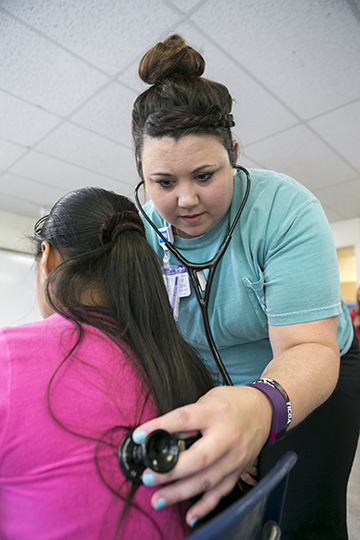
Samford University’s Ida V. Moffett School of Nursing has received $350,000 to provide tuition assistance for family nurse practitioner students committed to serving patients in rural or underserved areas. The Advanced Education Nursing Traineeship (AENT) funding, provided by the U.S. Department of Health and Human Services, will support 20 students seeking master’s or doctoral degrees with the family nurse practitioner specialty in the 2016–17 year.
To be eligible for funding, students must live in rural or underserved areas of Alabama or neighboring states, come from diverse backgrounds, or indicate interest in working in rural or underserved areas. Eligible students must submit an application to be considered for assistance.
Samford’s family nurse practitioner program has a long history of preparing graduates for service to underserved populations. According to Nena F. Sanders, nursing school dean and vice provost for the College of Health Sciences, more than 60 percent of graduates from 2014–15 are currently employed in practice settings that substantially benefit rural and underserved populations.
“The data proves what we already knew,” said Sanders. “Graduates from Ida V. Moffett School of Nursing’s family nurse practitioner program are assisting in meeting the increased demand for access to quality primary care services in Alabama and throughout the nation. Because of this grant, we will be able to make an even greater impact on the provision of quality primary care services in our state and nation.”
According to Jill Cunningham, chair of Samford’s family nurse practitioner department and project director for the grant, funding will focus on providing seamless academic progression for the associate degree nurse to obtain a graduate degree with eligibility to sit for national family nurse practitioner certification. Samford offers both RN-to-M.S.N. and RN-to-D.N.P. pathways for associate degree nurses seeking graduate degrees with the family nurse practitioner specialty.
“Our unique pathways for associate degree nurses are unlike any other in Alabama or the Southeast region,” said Cunningham. “These programs are highly sought after by associate degree nurses seeking seamless matriculation into a nurse practitioner program, and we are excited to utilize grant funding to assist in their transition.”
Sanders explained that as the health care environment becomes increasingly complex, advanced practice nurses will need the highest level of knowledge and practice expertise in order to respond to the evolving demands of practice. “Alabama Board of Nursing assessment data indicates that 41 percent of the nursing workforce in Alabama are prepared at the associate degree level, representing the largest applicant pool for target of seamless education to increase the availability of primary care providers,” she added.
Alabama is home to 29 associate degree nursing programs, the majority of which are located in rural areas. According to Cunningham, students frequently express the desire to return to the rural community in which they live to serve as a nurse practitioner in primary care upon graduation, but are hindered by the time and financial commitment required to complete graduate education.
“The AENT funds will allow associate degree nurses from these rural areas to obtain a graduate degree focusing on primary care of the community. Nurses who remain in their hometowns as nurse practitioners will provide support, expertise and primary care services while also serving as role models for other nurses in the areas,” said Cunningham.
Samford’s family nurse practitioner program prepares students to manage patients across the lifespan, and includes a series of core and specialty courses with linked practicum experiences that focus on diagnosis and management of patients in primary care. To learn more about the program, go to samford.edu/nursing.
